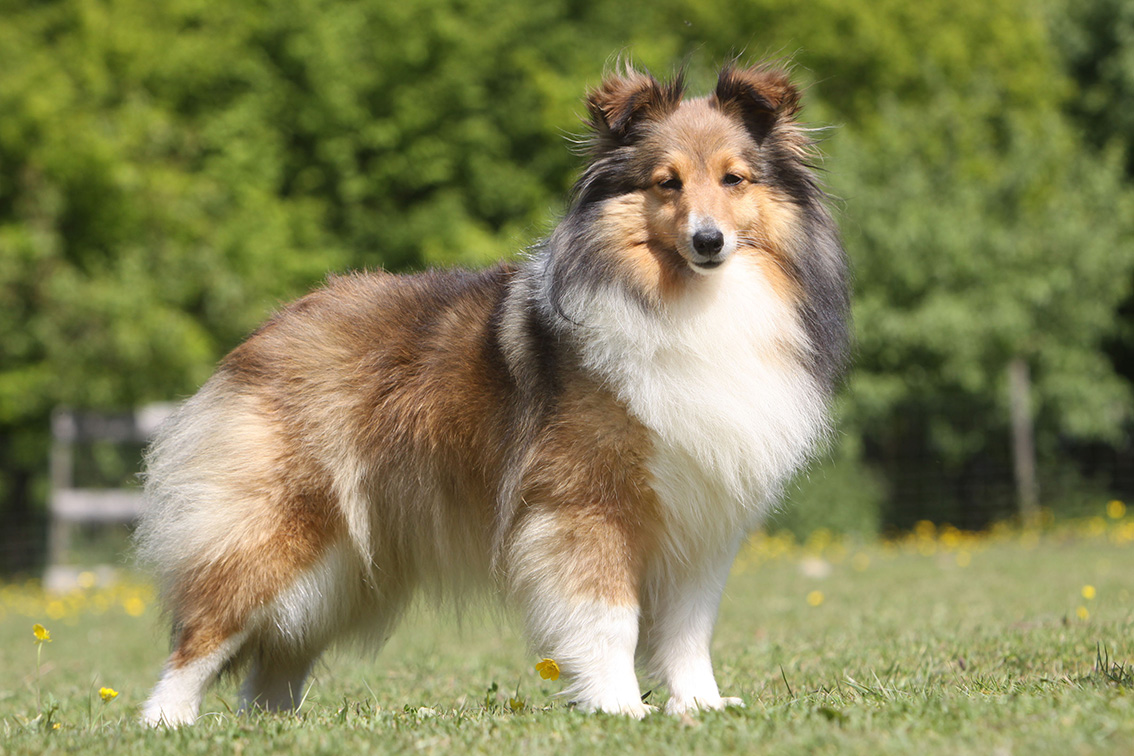Shetland Sheepdog

Description
The Shetland Sheepdog, often referred to as the "Sheltie," is a highly intelligent and agile herding breed that originated on the Shetland Islands, located to the north of Scotland. The breed was developed by crossing various herding dogs, including Collies, with smaller dogs to create a breed capable of managing livestock in the harsh climate and terrain of the islands. Shelties were primarily used to herd sheep and other livestock, and their quick learning ability and excellent work ethic made them invaluable to farmers. Today, the Shetland Sheepdog is a popular companion dog, known for its loving nature, trainability, and beautiful appearance.
Physically, the Shetland Sheepdog is a small to medium-sized dog, typically standing between 13 and 16 inches at the shoulder and weighing around 15 to 25 pounds. It has a well-proportioned, athletic build, designed for agility and speed. One of the breed's most striking features is its thick double coat, which is abundant and luxurious, with a soft undercoat and a longer, harsher outer coat. The coat comes in a variety of colors, including sable, black, and merle, often with white and tan markings. Shelties have a well-defined head with a refined, gentle expression, and their long, graceful tails and erect ears complete their appealing, elegant appearance.
Temperamentally, Shetland Sheepdogs are known for their intelligence, loyalty, and affection. They are highly trainable, often excelling in obedience training and dog sports such as agility, obedience trials, and herding competitions. This breed is eager to please its owners, making it a great choice for active families or individuals who enjoy training their dogs. Shelties are also known for their herding instinct, and they may attempt to herd children, other pets, or even vehicles, as they were originally bred to control livestock. While they are generally gentle and friendly, they can be reserved or shy around strangers, making them excellent watchdogs.
Despite their agility and energy, Shetland Sheepdogs are typically calm and content in a home environment, as long as they receive enough physical exercise and mental stimulation. They thrive on human companionship and enjoy spending time with their families. Regular exercise, such as daily walks, playtime, or engaging in dog sports, is important to keep them mentally and physically fit. Their thick coat requires regular grooming to prevent matting and to keep them comfortable. While Shelties can be vocal, often barking to alert their family of potential intruders, they are generally well-behaved and adaptable dogs. Overall, the Shetland Sheepdog is a charming, intelligent, and loyal companion that makes an excellent addition to families, particularly those who appreciate an active, trainable breed.
History
The Shetland Sheepdog, affectionately known as the "Sheltie," is a highly intelligent and versatile herding breed that originates from the rugged Shetland Islands of Scotland. This breed was developed to help local farmers manage small herds of sheep and livestock in the harsh and windswept environment of the islands. The Sheltie’s small size, agility, and intelligence made it perfectly suited to its role, as it needed to be quick and resourceful to maneuver livestock on rough and uneven terrain. The breed’s origins likely involve a mix of native herding dogs, Scandinavian spitz-type dogs brought by early Norse settlers, and later crossings with other working breeds, such as the Rough Collie.
By the 19th century, the Shetland Sheepdog had become a recognizable and valued part of life on the islands, not only for its herding skills but also as a loyal companion. Its small size and resourcefulness mirrored the adaptability of the Shetland Islands’ ponies and sheep, which were bred to thrive in the limited resources of the region. Initially, the breed was referred to as the "Toonie Dog," derived from the word *tun,* meaning farm, further emphasizing its role as a practical farm helper.
In the early 20th century, the Sheltie began gaining recognition beyond the Shetland Islands. Breeders refined the breed by crossing it with the Rough Collie, which enhanced its appearance while preserving its herding instincts and intelligence. The Shetland Sheepdog was officially recognized by The Kennel Club in the United Kingdom in 1909 and by the American Kennel Club (AKC) in 1911, helping the breed grow in popularity as both a working dog and a family companion.
Today, the Shetland Sheepdog is celebrated worldwide for its intelligence, trainability, and affectionate nature. While it retains its herding instincts, it has also excelled in canine sports such as agility, obedience, and rally. The breed’s rich history as a hardworking and loyal partner reflects its enduring appeal and the dedication of those who have preserved its unique qualities.
Colors
• Black & Tan
• Black & White
• Blue Merle
• Merle
• Sable
• Sable & White
• Tricolored


